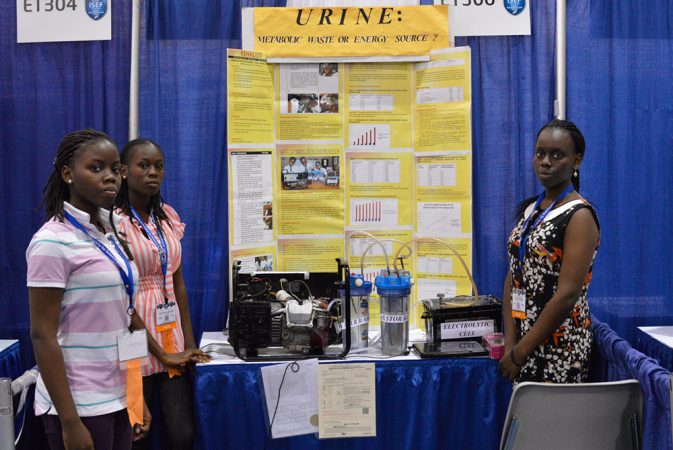Pee is for power
The water in urine can be a source of hydrogen for electrical generators
By Sid Perkins

To the body, urine is a waste. But to society, it could be a major resource, reports a trio of student inventors from Nigeria. They developed a system to produce fuel from urine. They do this by breaking down the water in urine to get hydrogen and oxygen. That hydrogen is a powerful source of energy. It’s also clean and readily available, the teens note.
In some parts of the developing world, electricity is not available all day. In other regions, its availability is unpredictable. “Where we live, almost everyone has a generator” to provide electricity at home, says Zainab Bello. She’s an 11th-grader at the Doregos Private Academy in Lagos. Expensive gasoline powers most of those home generators, she adds.
But that fuel can have other costs as well. For example, the generators that burn gasoline can release a toxic gas called carbon monoxide. (In large amounts in an enclosed area, carbon monoxide can kill. It prevents blood from picking up oxygen.)
So, Bello and two classmates, Adebola Duro-Aina and Oluwatoyin Faleke, designed a system that uses urine as the source of a cleaner fuel. Their system provides as much electricity as one fueled by gasoline. But it doesn’t produce carbon monoxide, the students note. Exhaust from the team’s urine-fueled generator is not toxic. It’s just water vapor. (Indeed, one inspiration for the teens had been the death of a family that lived nearby. The carbon monoxide from their gasoline-powered generator had poisoned them.)
Another advantage to urine as a source of fuel: It’s plentiful. Each adult produces between 1 and 2 liters (1 and 2 quarts) per day.
The heart of the team’s system is an ordinary generator. Families can buy one at many home improvement stores. But the teens modified theirs to run on hydrogen gas, not gasoline. They use electricity produced by their generator to break down the water in urine into hydrogen and oxygen. (The chemical formula for water is H2O. That means that each molecule of water contains two hydrogen atoms and one oxygen atom.)
The teens then bubble the hydrogen, a gas, through more water to remove impurities. Finally, the gas passes through a chemical solution to remove any water vapor that might be present. Now the hydrogen is ready to burn as a fuel.
As the process suggests, it takes a good deal of electricity to get the fuel — hydrogen — separated from water. So in the end, it may still be rather costly to fuel a generator this way, at least in regions where gasoline is rather inexpensive. Its real advantage, therefore, might be its ability to greatly reduce toxic pollution associated with household power generation.
One liter of urine can produce enough hydrogen gas to run an electrical generator for 6 hours. (A gasoline-fueled generator needs about 7 liters of that fuel to run for the same length of time.)
The team presented its design May 13 in Phoenix, Ariz., at the Intel International Science & Engineering Fair. The Society for Science & the Public, which created the fair in 1950, still runs the competition. (SSP also publishes Science News for Kids.)
In the future, the team plans to study possible uses for the chemicals left over when the water is removed from urine, says Bello. Those chemicals might be useful as fertilizers, she notes.
Power Words
atom The smallest possible unit of a chemical element. Atoms are made up of a dense nucleus (which contains positively charged protons and neutrally charged neutrons) that is orbited by a cloud of negatively charged electrons. Because atoms are neutrally charged overall, the number of protons inside the nucleus must equal the atom’s number of electrons.
carbon monoxide A toxic gas whose molecules include one carbon atom and one oxygen atom. (The “mono” in “monoxide” is a prefix from Greek that means “one”.)
molecule An electrically neutral group of atoms that represents the smallest possible amount of a chemical compound. Molecules can be made of single types of atoms or of many different types. For example, the oxygen in the air is made of two oxygen atoms (O2), but water is made of two hydrogen atoms and one oxygen atom (H2O).







